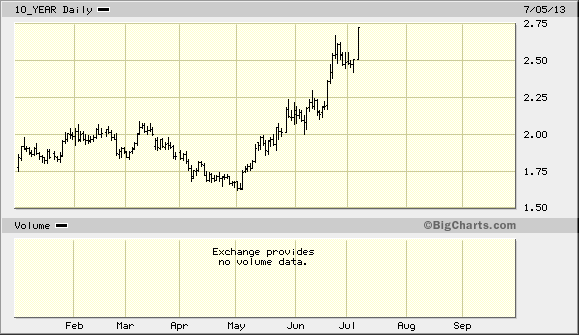The second quarter gave us quite the thrill. I’m calling it “The Great Bernanke Scare of 2013.”
After a monster first-quarter rally in income-paying securities, comments from the Fed Chairman that he might—just might—taper quantitative easing by early next year led to the worst correction in bonds, MLPs, REITs and other “income focused” investments in nearly two years.
Interestingly, “high beta” sectors such as emerging markets and “periphery” European markets also took a beating. It was something of a barbell correction in which both the most conservative and the most risky sectors got hit the hardest, while what you might think of as “mainstream stocks” held up relatively well.
Emerging markets were affected by more than just Fed fears, however. Unrest in Turkey caused a collapse in the Turkish stock market—which had previously been one of the best-performing markets in the world and a source of relative return for the Sizemore Capital Tactical ETF Portfolio.
Slower growth in China and fears of a Chinese banking crisis also helped to push emerging market stocks sharply lower.
Where do we go from here?
I stand by my original view that the bond market overreacted to Bernanke’s comments and did so by a wide margin. I expect the ten-year Treasury yield, which at time of writing had just shot above 2.7% on a positive jobs report release, to settle into a fairly long-term range of 1.9% to 2.3%—a view that bond market legends Bill Gross and Jeffrey Gundlach would seem to share given their recent bullish comments on the sector.
The income sectors that got hit the hardest—such as REITs and MLPs—are off their recent lows, and I expect investors to return to these sectors in the second half. In the Dividend Growth Portfolio, Sizemore Capital took advantage of the selloff to add to our long-term positions in National Retail Properties ($NNN) and Realty Income ($O) and to initiate new positions in competing retail retails Cole Properties ($COLE) and American Realty Capital Properties ($ACRP).
Each of these meets my basic criteria as a dividend growth investment. They pay a relatively high current yield, and their property portfolios are structured to make an increasing cash payout very likely over time. They also fall into a “sweet spot” in that their portfolios are defensive yet also offer decent protection in the event of higher-than-expected inflation.
I additionally made multiple changes to the Tactical ETF Portfolio. I initiated a short position in Japanese government debt via the Powershares DB 3x Inver Japanese Gov Bond ETN ($JGBD).
I also shifted the equity portion of the portfolio away from the “mega caps” in the WisdomTree Large Cap Dividend ETF ($DLN) to a more growth-oriented alternative: the Cambria Shareholder Yield ETF ($SYLD). And consistent with my view that more cyclical sectors will lead in the second half, I initiated a position in the Technology Select Sector SPDR ($XLK).
In both the Dividend Growth Portfolio and the Sizemore Investment Letter Portfolio, I sold the position in Silver Bay Realty Trust ($SBY), which has failed to meet expectations. I remain wildly bullish about the prospects for the rental housing market, but I fear that a flood of new traded Wall Street alternatives has created something of a glut in the supply of the stocks themselves (though not of the underlying houses).
Where do we go from here?
After the recent rout in emerging markets, several are beginning to look attractive to me again. European markets—and particularly periphery markets—also look attractive based on price and investor sentiment. I consider these fertile areas for investment in the second half.
